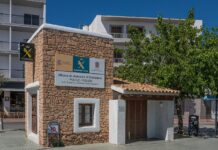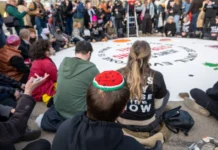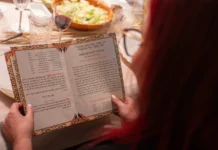More than 300 Houses of Life have been discovered in Italy and another 200 in France, Belgium, Poland, Hungary, the Netherlands, Denmark and Greece.
The moment that Bianca Castelli nee Campagnano and Alessandra Staderini walk into the room it is clear that they share a unique bond – something that transcends the relationship of even the best of friends. That’s because, 74 years ago after Nazi Germany had occupied Italy – when Staderini was just a baby and Castelli nine years old – the latter hid from the Nazis in the home of the former, whose family welcomed the Campagnano children with open arms.
Now, as the two elderly ladies awaited their interview with The Jerusalem Post last week at the Libera Università Maria SS. Assunta (LUMSA) in Rome, they were submerged deep in conversation and the palpable warmth and sisterly love between the two was heartwarming.
In June, the Staderinis were the first family to receive a “House of Life” plaque from the Raoul Wallenberg Foundation, which honors the Righteous Among the nations who risked their lives to shelter victims of Nazi persecution during the Holocaust.
Alessandra and Bianca’s mothers and grandmothers were fast friends, too. After the German occupation of Italy on September 8, 1943, Bianca’s family took shelter in a Rome building that belonged to a monastery. One night, Alessandra’s mother, Bice Staderini, had a dream that the children were in danger. She immediately picked up the phone to their mother, Elvira, and told her to send them to her.
The very next morning, Bianca and her brother, Marcello, joined the six Staderini children in their home, where they would remain for the next nine months. The Staderini children were forbidden from inviting their friends to their home, as they needed to keep the presence of the Jewish children there a secret.
The pair gets emotional when recalling their history. “Her mother was very determined and brave,” Bianca says, adding that her father, Fausto Staderini, also “was not an ordinary person.”
Fausto, she says, was a very popular man and was well-known. He was an engineer and the owner of a print shop that employed 200 people. He came from a well-known anti-Fascist family and the Raoul Wallenberg Foundation notes that due to this, the risk the family took in sheltering the children was even greater.
In addition to housing the children, their housekeeper delivered weekly provisions to their parents and grandparents, who were hiding in an attic in a building in the city.
“Alessandra was a very pretty baby…she was like a doll,” Bianca says fondly. “My father used to call her a “little ball” because she was plump,” she laughs.
When I broach the subject of the deep gratitude which the family surely feels for the Staderinis, Alessandra swiftly interjects. “We were friends before and we were friends after and there is no [need for] gratitude here. We are simple people,” she says.
For years these types of stories were not made public, because the saviors were so humble. Then, “10 years ago,” Alessandram 75, relates, taking her friend’s hand, “Bianca asked my sister why we didn’t apply for the honor of Righteous Among the Nations.” Yad Vashem recognized Fausto and Bice Staderini as such in 2009.
Unlike Bianca, 83, Holocaust survivor Gianni Polgar, 81, lost contact with his savior, Hugo Silvio Barbano. “We didn’t have contact with him, because we didn’t know anything about him,” he told the Post.
Barbano was the director of a boarding school called Collegio San Giuseppe, Instituto De Merode, which took in Polgar in October 1943, when he was seven. His brother joined him shortly after.
“He had been staying at another boarding school, but his friends recognized him playing in the street and started saying ‘look it’s Tommy Polgar, the Jew,” Polar relates. “So the boarding school called my mother and told her to take him.” The brothers remained at the Collegio San Giuseppe until the Allies liberated Rome on June 4, 1944.
During his time at the school, Polgar had to change his name to Franco de Renzini in order to hide his Jewish identity. “It’s not easy for a seven-year-old child to understand that he has a new identity, because if someone calls him by his name and he answers, he is at risk of being taken away,” he remarks.
Polgar’s mother used to visit her children every week at the school. “I had to call her “Auntie,” because my official story was that my parents died after the bombing [of Rome]. These things affected my psychology and stayed with me forever,” he reflects.
Polgar notes that the school rescued not just Jewish children, but also partisans and escaped British prisoners. During Nazi inspections, they all hid together in the basement of the school. “One of the Brits dressed up as a priest,” Polgar remembers.
“Barbano made it impossible for us to be caught,” he says, also recalling a fake Holy Communion he arranged for the non-Christians.
On February 14, this year, the Raoul Wallenberg Foundation officially declared this school a House of Life at a ceremony that included testimonies by Polgar and others.
LUMSA is working together with the foundation to raise awareness of the topic by involving high school and university students through conferences, art, and collaborative research. Some students, for instance, are involved in interviewing witnesses.
“I would like to stress that in these activities we aim to avoid stereotypes,” Prof. Giampaolo Malgeri of LUMSA tells the Post. “We don’t want to say all Romans were involved in saving Jewish lives… we have to be strict, they have to be checked. Not anyone can come and say they saved 20 Jews – talking is not enough. It’s important for the credibility and LUMSA is supervising this.
“This was a very Fascist area…. but underneath it there were people who did protect Jewish people,” he adds. “While some risked their lives, others pretended not to see.”
The Houses of life project is active across Europe, and in under three years more than 300 places of refuge have been discovered in Italy and another 200 in France, Belgium, Poland, Hungary, the Netherlands, Denmark and Greece.
“The numbers are growing by the day and our aim is to mark them all with a distinctive House of Life plaque, fully visible to visitors and tourists,” Eduardo Eurnekian and Baruch Tenembaum, chairman and founder respectively of the International Raoul Wallenberg Foundation, said in a joint statement.
They said that had been surprised to discover that many of these institutions were Catholic churches, convents, monasteries and schools. “The underlying objective is to raise awareness to the feats of the rescuers who acted behind those walls,” the statement said.
In addition to honoring people who saved lives, the foundation also recognizes those who redeemed cultural and religious symbols. Last week, Palermo Archbishop Corrado Lorefice received such an honor for having handed over to the Jewish community a church property that was built atop the ruins of the ancient Great Synagogue, 524 years after it was confiscated by the Church.
The Spanish Inquisition demolished the once-thriving Jewish life in Sicily; the majority of the island’s Jews were expelled, but a small number underwent forced conversions and remained in their native country. Today, a tiny Jewish community of several dozen has reemerged, with the help of Shavei Israel, which is active around the world in communities of Bnei Anousim (forcibly converted Jews).
Today they hold their gatherings in the apartment of community leader Evelyn Aouate. She invites me for Friday dinner at her home, and shows me her large living room in which the community holds prayer services. She looks forward to the opening of the synagogue, which is currently undergoing refurbishment and is expected to be ready next year.
The synagogue stands side-by-side with a church, and Aouate says that just as the Jewish and Christian communities used to live in harmony on the island centuries ago, “I think we’ll repeat history.”
Shavei Israel founder and chairman Michael Freund has in the past spoken of “the miracle that after more than 500 years there are still people in Sicily who proudly cling to their Jewish roots and it is testimony to the fact that neither the expulsion nor the Inquisition was able to extinguish the eternal Jewish spark in their hearts.”
Luciana Pepi, who teaches Hebrew language, culture and philosophy at the University of Palermo, may or may not be a descendant of one of those forcibly converted Jews Freund speaks of, but either way, despite her Christian upbringing she began to feel a natural love for Judaism after renouncing her birth religion at the age of 15.
She didn’t feel comfortable with Christianity, and when she began to study Medieval Jewish philosophy at university, she “suddenly felt a great love” and took to the Hebrew language with ease. She now converses with me with an excellent command of Hebrew, having spent significant time in Israel.
“The first time I went to shul was in Israel and I felt this was the place for me. The prayers felt natural to me,” Pepi says, describing her decision to convert. “I spoke to my father and I felt that he understood me. And then I thought of my father’s family.”
Pepi’s paternal grandmother’s name is Bologna, a Jewish name. “My father didn’t talk a lot, but he said he understood. He said it could be that there were Jews in our family.”
Pepi notes that when she teaches Jewish culture at university, her students sometimes tell her that they always light candles on Friday night, because their families have always done so.
“I think now that we have a synagogue, for many people who think they have Jewish roots or a connection to Judaism it will be easier for them to come back,” she opines.
Since The New York Times published a story about Palermo’s Jewish community, Pepi, Aouate and another convert, Maria Antonietta Ancona, all featured in the article, have garnered a lot of attention. Even during the few hours I spend at Aouate’s house dining with her, Pepi, and an American Jewish visitor to the city, Aouate receives a phone call from a man in London who was inspired by their story.
He comes from Ciminà, a commune in the province of Calabria, and though he is not Jewish, he would like to see a revival of the Jewish community there. Perhaps the story of Palermo will help bring back to life other Jewish communities, too.
The writer was hosted by the Raoul Wallenberg Foundation.

























